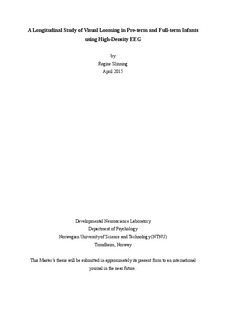| dc.description.abstract | Electroencephalogram (EEG) was used in full-term and pre-term infants at the age of 4 to 5 and 11 to 12 months to longitudinally study brain electrical activity as a function of visual perception of looming motion stimuli. The aim of the study was to find evidence for developmental differences between normally developing full-term and pre-term infants’ perception and processing of a virtual looming object approaching on a direct collision course with three different accelerations. Analyses of visual evoked potentials (VEPs) and temporal spectral evolution (TSEs) were used. VEP results showed full-term infants to significantly decrease their looming-related brain responses at the age of 11 to 12 months, where they showed their looming-related brain responses at a fixed time-to-contact irrespective of loom speed. The TSE results showed an increase in amplitudes observed as synchronized early beta band activity at the age of 11 to 12 months in full-term infants. The VEP and TSE results indicated that full-term infants have developed specialized neuronal networks for visual motion perception in the dorsal visual stream and are using a sophisticated and efficient timing strategy to time their brain responses to the virtual collision, indicating that they have developed prospective control at the age of 11 to 12 months. The pre-term infants, on the other hand, did not significantly decrease their looming-related brain responses at the age of 11 to 12 months where they did not time their looming-related brain responses closer to time-to-collision. The TSE results showed that two of the pre-term infants showed little to no synchronized early beta band activity at the age of 11 to 12 months. The results from the VEP and TSE analyses indicated that the pre-term infants may not have developed specialized neuronal networks for processing visual motion, are using a less efficient timing strategy to time their brain responses, and consequently may have problems with prospective control at the age of 11 to 12 months. Together, these findings suggest that pre-term infants at 11 to 12 months of age have problems with visual motion processing, a dorsal stream function. However, the results of VEP duration significantly decreased for both group of infants at the age of 11 to 12 months indicating that they need less time to process the looms and that they have a sufficient amount of myelination of neurons in the dorsal visual stream. More follow-up research is needed to further understand the neurobiological development in pre-term children early in development, since early measures could, in the long term, help pre-term children develop cognitive abilities that allow them to reach their true intellectual and social potential. | nb_NO |
